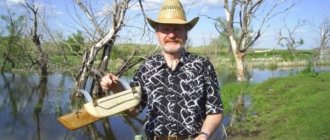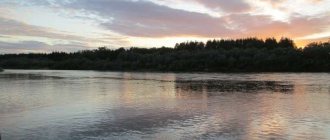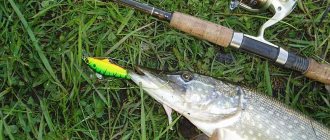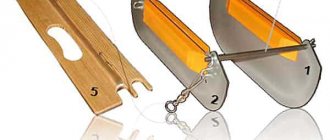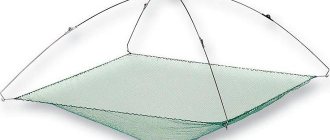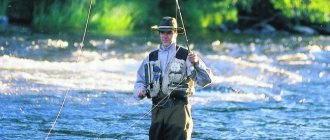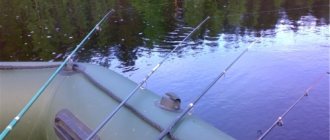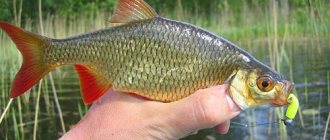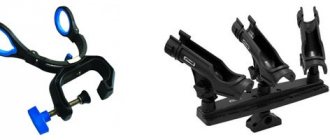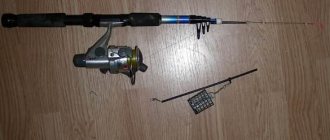Observing how fish on warm days grab various insects that fall on the water, a simple principle of fishing with a boat was invented, it is also called a water snake. This design received this name due to the fact that the principle of its operation resembles a kite.
If the air version is launched against the wind, then the water version is launched against the current. Before you start this method of fishing, you should get the hang of using this gear. The boat develops physical fitness, composure and observation skills in fishermen.
What is a fishing boat?
In appearance, the boat resembles a sleigh or a small boat. Wood, polystyrene foam, plywood, and plastic bottles are suitable for its manufacture. If you use wooden planks, it is better to take hardwood, such as oak or beech.
The design is represented by two planks, one of which should be 15-40 mm smaller than the main one, connected by two metal rods. In the construction, the planks must be parallel. Holes are made in the smaller board for attaching fishing line. The leashes are attached to the fishing line in such a way that the first one near the boat is short, and each subsequent one is longer than the previous one.
The essence of the boat fishing method
Various insects cling to the hooks: flies, grasshoppers, mole crickets, saran. The ship is lowered into the water against the current. When he swims away, the line will begin to unwind. Leashes should be spaced one meter apart to avoid tangling. To the place where there is a concentration of fish, liners with bait are brought, which dangles in the air.

Near the desired location, the bait is lowered so that it barely touches the water. The fish thinks that the insect is wet and cannot fly up.
At this moment, she begins to attack the prey and hooks. After this, the trophy should be pulled to the shore and caught with a landing net, since near the shore the fish may begin to flutter and slip away.
Where is the best place to fish by boat?
This tackle can be used on any water where there is a current or where the wind often blows. It is also convenient to fish with them where there is a lot of algae near the coastline and the use of a fishing rod is difficult.
In some cases, fishermen also use watercraft for fishing with such gear. In order for the “boat” to sail to the required distance, the fisherman only needs to adjust the speed of the boat.
Read! Fishing for burbot in early spring
This gear is mainly used to catch predatory insects, so it becomes most effective during the period when insects fly out. It has proven itself especially successful when fishing for pike, perch, and chub.
You can attach any insects to the hook when fishing with a boat, but you can also successfully catch fish using artificial bait.
Advantages and disadvantages
- Flaws. A water snake is an almost fail-safe tackle; the only thing that may not suit fishermen is that it falls in a strong current. But this can be combated with the help of stabilizers that are attached to the board. They are usually made in the form of blocks floating on water.
- Advantages. Compared with the minimal number of disadvantages, the boat has a number of advantages. It is very light and easy to transport. Suitable for any type of fishing. It is also suitable for almost all types of rivers where there is a current.
Boat equipment
The most convenient way is to control the boat using a strong rod, preferably not carbon fiber, but composite or even fiberglass. These are stronger and more tenacious rods, which is what is needed to control a bulky boat in strong currents. Fishermen, of course, often do without a rod. The line is held with your hands, reeling in and dropping the line. But this method has some disadvantages.
As with catch fishing, the fishing line can get caught on roots and bushes on the shore and become tangled. In addition, when fishing with your hands, it is not possible to lift the equipment higher above the water, which is often necessary when fishing with surface baits. Therefore, using a fishing rod is more preferable. But for fishing with a boat, it is better to remove the flexible tip. It will not be needed for playing with bait and hooking, as in a spinning rod, and it will be more difficult to control the boat with it. It is better to use a power coil. It could be a multiplier or even a simple inertia.
To tow the boat, a braided cord or thick monofilament line is used. The leashes are placed thin. If the object of fishing is a chub, then a fluorocarbon line with a diameter no thicker than 0.18 mm . Streamers and flies are often attached to such a fishing line, which only touch the surface of the water.
The boat is also used by pikemen and quite successfully. They set up metal leashes and catch pike with fry and live bait.
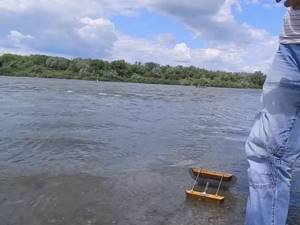
Share with your friends!
What kind of fish can you catch on a boat?
A boat approach for catching a variety of fish: pike, chub, asp, trout, bream, ide, perch and others.
- Pike does not react well to bait and is best caught on riffles with a grassy water surface. Its bite is not so easy to notice, since the bait suddenly disappears, and the fishing line sags as if the hook was caught on a stump. The pike does not create much resistance when hooking, so it goes to the shore quite calmly.
- The chub very carefully grabs the fly , but at the same time he is in constant interest in it. The fish loves to play with the bait, so you can see splashes under the insect, but there will be no bite. If a chub gets hooked, then the fish are first felt, and only then a splash is visible. The fish loves to resist, but it is enough for him to lie on his side and he stops any attempts to escape. Rarely gets off the hook.
- The ide takes the fly quite often. To catch it, you need to put a lot of effort into hooking it. This fish requires a very strong and sharp hook. This may be due to the fact that the fish takes the fly into its mouth, but the hook does not stick anywhere, but lies in its mouth. Ide is considered not a very successful trophy for this type of fishing. He resists almost the entire time until he gets to the shore.
- Perch often rarely catch a boat. In addition, large fish are considered a fairly rare catch. But at the same time he excitedly grabs the bait.
- On warm days, the asp rises to the surface of the water. It grabs the bait quite greedily with a very sharp jerk. The bite is characterized by a strong splash under the insect and a powerful jerk. The fishing line sags in the place where the leash is attached and you can see what kind of bait the asp was caught with. Creates virtually no resistance. He doesn't get off the hook unless he starts making mistakes while surviving.
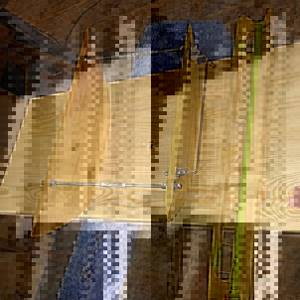
Lures used
The following are used as attachments for boats:
Artificial flies that imitate insects, including various dragonflies, flies and butterflies. Also, they can be wet or dry. Dry baits should easily jump on the water surface, and wet ones should have a bright game with a slight immersion.
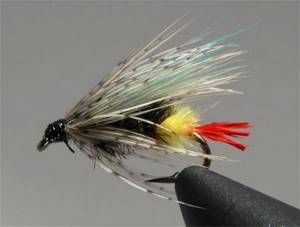
Spoons (spinning spoons). They must have a suitable size and weight so that when retrieved they do not stretch on the very surface of the water surface, but give good play when immersed at least forty centimeters.
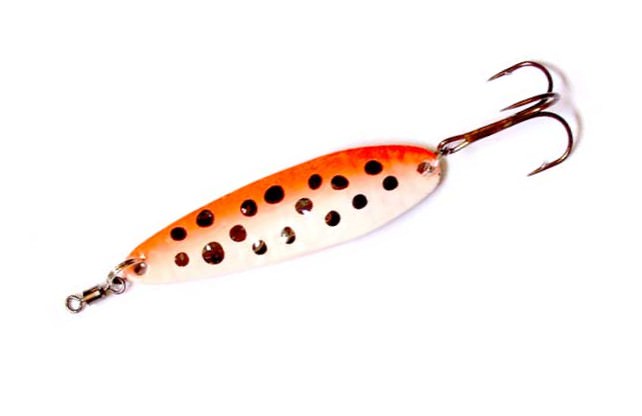
Boat fishing technique
The fishing technique includes the following steps:
- Launch.
- Wiring (in standing and running water).
- Fishing.
Launch
The launch of this gear is done according to the following scheme of actions:
- Adjust the position of the boat for launch and stick the flies into the cork strip at the upper end of the main board.
- Attach the tow line clip to the switch safety bracket.
- Place the spinning rod on a coastal area, not far from the water.
- Attach the fishing line to the fastener, first unfasten it from the fuse.
- Release the towing line from the elastic band.
- Starting with the first fastener, begin to release the flies one by one.
- When all the flies are on the water, you should check the float for support and position the boat at a slight angle from the direction of the current.
- Take the spinning rod and turn off the reel brake. Unwind the line fifteen meters and press the reel tightly.
- Use the tip of the fishing rod to push the boat into the water.
- Start moving the boat in the desired direction, while simultaneously releasing the fishing line to the required length.
Wiring (in still water)
Wiring in standing water has its own characteristics. The force that moves the boat away from the shore should be created here not by the current, but by the movements of the fisherman, so the latter must constantly move slowly along the shore to ensure the necessary tension in the fishing line.
It is carried out according to this principle:
- The fisherman must walk slowly along the coastal area, making short stops. At the same time, he must reel in the fishing line with a reel.
- Then, when the boat sails closer to the shore, you should switch the reverse simultaneously with the fisherman moving in the opposite direction.
- The length of the fishing line must be controlled and set in such a way that the flies pass close to the already fished area of the reservoir.
Piloting a boat in running water
On reservoirs, fishing in running water is done using dry and wet flies.
Let's look at wiring with dry flies:
- The boat should be guided downstream, since it is thus in front of the fisherman, which makes the process of adjusting it easier.
- You should hold the fishing rod with your right hand, and tighten the reel spool tightly with your thumb.
- The line must be kept taut at all times.
- Wiring should be done close to the shore, moving the boat with short pauses along the same line. This will make it possible to fish a large area near the shore with flies.
You should navigate a boat using a wet fly as follows:
- Lower the boat downstream.
- Lower the fishing rod horizontally along the shore.
- Then the fisherman must begin to move along the coastal zone at the speed of the current.
- Place the towing line on the water and bend it in an arc. Then drive it under the surface of the water with the current.
- Next, you need to make sure that the towing line does not go higher than the surface of the water, otherwise the wiring will be damaged and will have to be re-done.

Fishing
Fishing has the following features:
- When fishing, the fishing rod must be kept in a horizontal position. This reduces the angle between the leash and the towing line. If the rod is in any other position, this may contribute to the fly being pulled out of the catch's mouth.
- Since in the first fifteen seconds the fish is not yet aware of the danger and does not resist, the fisherman must use them for fishing. During this time, he needs to have time to put the reel on the brake, put the fishing rod on the shore and grab the catch with his hands.
Depending on the place of fishing, the wiring of the boat has the following features:
- You should know that bodies of water that do not have enough space are not suitable for launching a boat. Also, you should not take risks and launch the boat from shores that are densely overgrown with algae.
- It is better to launch the boat in areas where the bottom is uneven and there are sharp changes in depth, since this is where fish most often gather. Wiring in such places should be done at medium speed in order to attract, but not scare away the fish.
- Low banks should be fished immediately, gradually moving to deeper areas. This way you won't miss large concentrations of fish.
- As practice shows, fish bite best on flies at a depth of no more than one meter, so there is simply no point in taking the boat to too great depths.
- If the river is small, then you need to fish it from the opposite bank, smoothly driving the fish towards the bank you are on. Thus, the boat will bring with it a lot of catch.
- If the fishing takes place on an open lake, where there are no bushes or other vegetation, then the fisherman must wear special camouflage clothing in muted tones so as not to scare away the fish.
Depending on the type of fish, the wiring method has the following features:
- When catching an asp, you should know that it always swallows the fly very quickly. This can be determined by the characteristic splash of water under the location of the flies, and the strong jerk that follows. In order to successfully pull out a caught asp, the fisherman must make several jerks with the fishing line to slightly weaken the resistance of the fish. After this, the asp weakens a little and approaches the shore more calmly. Its gatherings happen infrequently and are mainly due to the fault of the fisherman.
- The chub is always interested in flies, but pecks at them rather restrainedly. His bite can be seen by the splash above the fly, but there will be no jerk on the line. In such cases, you should take your time and wait for another bite so that the chub is sure to catch the hook. When he swallows the hook, the fisherman feels strong jerks as the fish begins to resist. When fishing for a chub, it should be positioned on its side so that it loses its strength faster and does not twitch so much. Also, you should know that chub are better caught with a wet fly.
- The ide bite on a fly is very original. First, the fisherman sees waves near one of the flies. Then he makes a sharp jerk and several splashes at once. When swallowing a fly, the ide often does not catch on the sting of the hook, but simply heals strongly with its mouth, so if it is sharply hooked, it can simply spit out the hook and go back into the water. In order to successfully deliver the ide to the shore, you should carefully but quickly pull it up and make several hooks near the shore. In addition, the fisherman must be prepared for the fact that the closer the fish comes to the shore, the stronger and sharper its jerks and resistance become.
- Perch is usually caught on a boat completely by accident in shallow areas of lakes. He grabs the fly quickly, often jumping out of the water after it. Larger perches are caught very rarely with such gear, so they are not of particular interest.
- Pike usually grab a fly in shallow water that is overgrown with low algae. Its bite is also unusual, since the fly suddenly goes under the water, and the towing line sags greatly, which looks like a hook. As a rule, after hooking, the pike does not offer much resistance and is pulled calmly onto land. It is interesting that the pike grabs the fly only with the tip of its jaw, without damaging the leashes from the fishing line.
Conditions required for boat fishing
A water kite is launched against the current at a certain angle, which is 25-30 degrees. It can be launched at a long distance from the shore if you let go and then pull up the line.
If the current in the reservoir is moderate, then the fisherman has to walk along the shore and carry out the same procedure with the fishing line:
- The current from the shore should be at a distance of 20 meters. This is necessary so that the fish does not see or hear the fisherman.
- In order for the boat to float well on the water and not fall, you should select a current at a speed of 3 to 10 kilometers per hour.
- The place where fishing will take place must be accessible to the fisherman.
- The current speed should be maximum from the shore, since fish can live at a distance of 30 meters.
- Before you fly a water kite, you need to make sure that there are no plants on the surface. You should also avoid sunken objects as they can get caught in the hooks.
Boat equipment
The component of the boat includes a fairly small number of devices, the main ones of which are:
- First of all, the design of the boat itself, which can be made of any non-sinking materials: foam plastic, wood, etc.
- A piece of fishing line that runs from the structure to the leash. You should always have a couple of spare pieces in stock. Also, the main fishing line of the tackle is 0.4 mm in size.
- Several leashes, which are made from the main fishing line, two or three of them are needed.
- It is better to take a fishing rod in the form of a spinning rod, the length of which should not exceed 3.5 meters.
- The reel comes with a reverse lock feature.
- Hooks are taken with two hooks, sometimes with three hooks.
Making a boat with your own hands: a step-by-step process
Any fisherman can make such a design with his own hands. Before you start manufacturing, you need to select suitable materials, tools and drawings, which are easy to find on the Internet.
The most reliable design is made of dense wood: oak, beech. If you take another material, then you will need to additionally treat it with water-repellent impregnations.
Step-by-step construction of a boat:
- First of all, you need to prepare two planks. One should be taken larger, and the second smaller, with a thickness of 12-14 mm. The elements are made in the form of a trapezoid.
- The side edges are cut with oblique cuts.
- Holes are made in one and the second plank. Some will serve to connect the main halves of the boat, and the second are needed for installation with the main fishing line.
- For connection, two threaded studs and four nuts can be used. The boat is attached to the main line with a bracket, which is mounted to the base with a nut and screw. To ensure that the structure does not wobble and is held firmly, you should use a drill when drilling holes in the wood of the same diameter as all fasteners.
- The planks are connected using pins and nuts. After which the bracket is attached.
- Due to the fact that two holes are used, the bracket can be moved in the opposite direction. This maneuver will help adapt the structure to any direction of flow.
- In order for the sled to be visible from the water at a height of 5 cm, lead plates must be attached to the bottom of the planks. This can be done using glue, screws or nails.
The finished design is ready for use.

Basic methods of boat fishing
Experienced fishermen have noticed that the main methods of fishing with a boat depend on the habitat of the fish, the current, and the weather.
Of all the methods, there are four main ones:
- A water snake can be used on rivers where there is an increased amount of all possible thickets and grass. It is best to catch pike in such reservoirs. Use two leashes with bait in the form of a frog or small fish. Double or triple hooks are used. The leashes are attached to carabiners, which are installed on the main fishing line. The distance between leashes is from 2 to 10 meters. The front nozzle is carried along the top of the grass, and the rear one simply goes through it. More often, fish bite occurs in the distant grass growth area.
- The ship is designed for rivers with wide rapids and a current that does not allow one to go far into the water. In this case, a reverse fishing device is used. In this case, three or even four leashes are used. Artificial baits - flies - are suitable for bait. Triple hooks are used to reduce the chance of fish getting lost.
- This method is somewhat similar to the second. But here a boat is used when catching chub at medium speed currents. Mostly the bite occurs under the shore, where there is vegetation. Butterflies and grasshoppers are used for bait. Triple hooks are better suited. Leashes are used quite long, up to 3 meters.
- The method is designed for fishing in reservoirs with moderate currents. Insects are suitable as baits. If you feel a bite, then the rod lies on the ground and at the same time the leash begins to move in the direction where the fish is moving. The hook can be done in just a few seconds by pulling the line up.
Nuances of pike fishing
The main attachment for the boat is an artificial fly. You can do it yourself.
- Important! Before tying a fly, it is better to dip the hook in moisture-resistant glue and let it dry thoroughly, since under this attachment the hooks quickly rust and lose their former characteristics.
To rig a boat, I often use polyethylene attachments, which can be purchased at any fishing store. The pike actively takes them, but sometimes spits them out, so if possible, use flies with a soft body, knitted or even fur. In my collection there are sets of various flies that imitate all types of insects.
It is best for pike to take the fly on shallow riffles that are already overgrown with grass. How does a pike bite? She is incredibly cunning and even bites like no other fish does. She bites unexpectedly, carefully, without much jerking. After which the towing line immediately sags, as if the hook had caught on snags.
As soon as I hook, the pike does not show active resistance, making it very easy to pull it out of the water. In my experience of fishing on a boat, I have never had a pike come off a hook.
Everyone can try out this non-standard technique in Sazanya Bay. Here you will definitely catch the long-awaited trophy!
